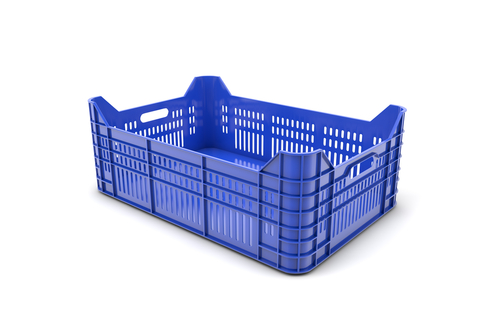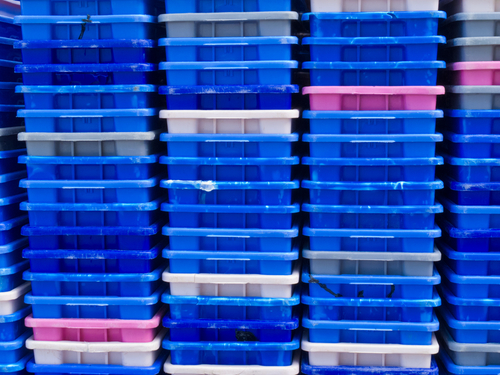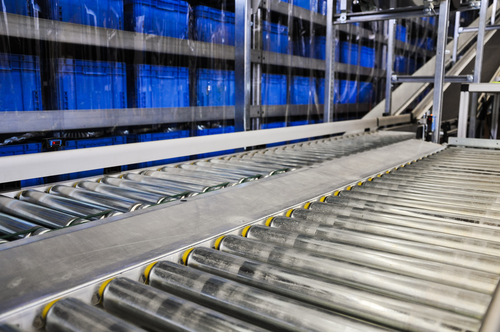
When researching warehousing and packing containers, there’s a good chance you’ll come across the phrase “nesting tote” or “stack-and-nest tote.” No, these aren’t what birds use to tote their groceries (though they could, we suppose). They’re actually versatile, space-saving storage and shipping containers that ease workflow. Nesting totes are used in many different industries, from storing and shipping delicate cosmetic products to food and drinks, and they can help revolutionize your facility’s processes.
If you’re new to the world of packaging and warehousing, think of nesting totes as similar versions of the bins used by the Transportation Security Administration (TSA) in the security line at the airport or bins carried by bussers in restaurants. Packing totes have several unique features that make them preferable in various applications. For one, they nest into one another when empty, meaning they can be easily stored when not in use (just like the TSA stores them beneath the security table). Most styles can also be used with or without lids.
The majority of plastic industrial nesting totes are made of thick high-density polyethylene (HDPE) which provides a durable, long-lasting appeal. Because of this, nesting totes can be used in conveyor systems and many are compatible with automated systems. Still, you can purchase long-lasting nesting totes constructed from metal, wire mesh stainless steel, or fiberglass. Any of these materials make a sturdy, lasting alternative to cardboard containers.
Applications for Nesting Totes
- Nesting Totes for Conveyor Systems—Modern-day distribution and fulfillment centers prefer nesting totes in conveyor systems. They transfer products to various locations—shipping, receiving, order picking, and more—via conveyor belt. Certain brands of nesting totes, particularly those by Akro-Mils, are uniquely designed to move with ease on conveyor belts because they’re lightweight and offer full 180-degree functionality. These totes easily attach to conveyor belts and eliminate hiccups thanks to their no-slip grip bottoms.
- Nesting Totes for Food Service—Because nesting totes are so versatile, many food service facilities have come to rely on them, too. However, it’s important to choose food-grade nesting totes for such applications. These totes are made with the same durable yet lightweight materials as regular industrial nesting crates but are FDA-approved for use with food items. They’re a good choice for bakeries, food manufacturers, and food distribution centers looking for space-saving solutions.
- Nesting Totes Instead of Cardboard Boxes—As you know, reusable plastic bins are costlier upfront compared with cardboard, but they’re still an extremely wise investment. They can be used literally thousands of times and should last several years. Additionally, plastic nesting totes are so much more reliable than cardboard. They’ll easily handle spills. Perhaps one of the best reasons to use plastic containers instead of cardboard ones is that they’re much more environmentally friendly.
- Nesting Totes for Storage—Stack and nest containers come in so many unique sizes and styles, so they’re perfect for various storage applications. We recommend these types of totes for temporary or adaptable storage, since their primary benefit is that they can be stacked to save space while not in use. Many different sizes and styles are available for various storage applications.
Nesting Tote Options
We use the phrase nesting tote relatively broadly here at Container Exchanger. Even though many of these containers are, indeed, totes, some are more like baskets, pails, or trays. You can use nesting tubs for things like food processing (especially picking and sorting produce) and employ trusty, nesting buckets for liquids, grains, and small, non-packaged items. Of course, you should choose your nesting tote based on the products you need to move, ship, or store.

Not sure which brands to choose? Akro-bins’ popular nest-and-stack totes are made in the U.S. and are a popular choice for conveyor belts due to their grip-style bottom. If you aren’t sure which kinds of nesting containers are best suited for your transfer, storage or shipping applications, don’t hesitate to reach out to us for personalized advice. We’d be more than happy to help you decide which style is best for your budget and needs.
